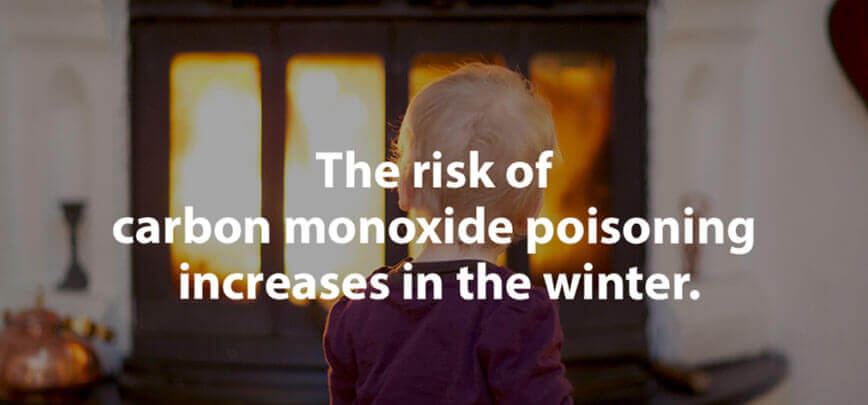Carbon Monoxide Poisoning Risks Increase in Winter
Every year, Canadians turn up the heat to combat the chilling effects of the Canadian winter. But if we’re not careful in doing so, we also increase the dangerous emissions that can lead to carbon monoxide poisoning.
We often hear about carbon monoxide during the winter months, but do we know why we’re exposed to this lethal gas? What are the effects of carbon monoxide poisoning, and what can we do to protect ourselves against it?
What is Carbon Monoxide?
Carbon monoxide is an odourless, colourless, tasteless gas that is produced when you burn fuel. If carbon monoxide builds up indoors without proper ventilation, it can kill you.
It’s been estimated that 150 Canadians die every year from carbon monoxide poisoning, but without a national database tracking this information, the number could be much higher.
Naturally, the risk is highest during the winter, because that’s when we tend to run our furnaces and other fuel-burning heating appliances the most.
What are the Signs of Carbon Monoxide Poisoning?
People who are affected by carbon monoxide poisoning often display “flu-like” symptoms, and may also complain of:
- Headache or dizziness
- Weakness
- Upset Stomach
- Vomiting
- Chest Pains
- Confusion
Breathing in a lot of carbon monoxide can lead to unconsciousness or even death. This is part of the reason why it’s called the silent killer: it can take you while you’re sleeping before you show any symptoms.
If you or someone in your family seems to be suffering from carbon monoxide poisoning, head directly to your nearest emergency room or call 911.
Reduce the Risk of Carbon Monoxide Poisoning
You can’t stop your fuel-burning appliances from emitting carbon monoxide, but there are some steps you can take to make sure your family is protected from its harmful effects. Here are seven easy ways to make your home safe from carbon monoxide poisoning:
- Install a carbon monoxide detector: An essential part of home safety, install a battery-operated or battery back-up carbon monoxide detector in your home where it will wake you if it sounds the alarm, such as outside your bedroom. Detectors with digital readouts can tell you the highest level of carbon monoxide concentration in your home. Change the batteries twice per year when you change your clocks, and replace the entire unit every five years.
- Regularly service fuel-burning appliances: Your heating system, water heater, and any other gas, oil, or fuel-burning appliances should be serviced every year by a qualified technician. If you detect an odour from these appliances at any time, they could be leaking carbon monoxide and need servicing.
- Clear your vents: Ensure that all ventilation systems, such as floor and dryer vents, are clear of debris or obstructions. This goes for both inside and outside vents that are crucial to directing carbon monoxide outside.
- Keep the barbecue outdoors: We all miss barbecuing outdoors, but because they’re designed to be used in open-air environments, running that barbecue inside can be dangerous. This also goes for outdoor heaters, generators, and stoves that burn fuel.
- Clean the chimney: Leaves, dirt, and other debris can block your chimney and cause carbon monoxide buildup in your home, so have it completely cleaned every year.
- Be careful with heat sources: Using gas ovens or ranges to heat your home can also cause a buildup of carbon monoxide, so use them only for cooking.
- Careful running the car: Even if your garage door is open, it’s dangerous to run your vehicle inside a garage that is attached to your house. If the garage is detached, open the door to let the fresh air inside while running your vehicle.
Remember to also apply these tips to your cottage, cabin, or camper to keep your family safe when away from home too.
What to Do If Your Carbon Monoxide Alarm Goes Off
First of all, don’t ignore it! Here’s what you need to do when your alarm sounds:
- Check for signs of poisoning: If anyone in your family is showing signs of carbon monoxide poisoning (see above), call 911 and get them to a hospital immediately. Fire services will let you know when it’s safe to return home.
- If no one in your family seems sick, open the windows to vent the house.
- Turn off all fuel-burning appliances, such as your furnace or gas oven.
- After the home is ventilated, reset your carbon monoxide detectors.
If your alarm doesn’t sound again, call a qualified technician to examine and service your appliances.
If it does go off a second time, and no one in the home shows signs of carbon monoxide poisoning, open the windows again and call fire services. They will inspect your home and let you know when it’s safe to return.
Stay Safe and Start Saving with Merit Today!
Make sure that you, your family, your property, and your business are protected during the winter and throughout the year! Contact your Merit broker for a quote today at 1-800-563-3383 or send an email. We’ll customize a homeowner and property, vehicle, or business insurance policy with affordable rates and deductible options that meet your needs.




